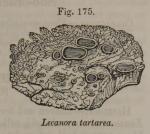 Cudbear is called by the Germans Persio [The word persio is probably derived from persica, on account of the resemblance of the colour of cudbear to that of a peach.]. The manufacture of this pigment was begun at Leith about the year 1777, by the late Mr. Macintosh of Glasgow, under the management of Dr. Cuthbert Gordon. From the latter gentleman's name the term cudbear (at first Cuthbert) originated.
Cudbear is called by the Germans Persio [The word persio is probably derived from persica, on account of the resemblance of the colour of cudbear to that of a peach.]. The manufacture of this pigment was begun at Leith about the year 1777, by the late Mr. Macintosh of Glasgow, under the management of Dr. Cuthbert Gordon. From the latter gentleman's name the term cudbear (at first Cuthbert) originated.
It is procured in the manner of Orchil, by the mutual action of some of the colorific lichens, air, and an ammoniacal liquor. White Swedish or tartareous moss (Lecanora tartaea) was formerly chiefly used in its manufacture. When the proper purplish red colour has been developed, the mixture is dried in the air and reduced to powder. I have found in the shops two kinds of powder of cudbear, one called red cudbear, the other blue cudbear. Both are purplish red—but one is redder than the other. I have likewise met with red and and blue cudbear pastes; but the term Orchil might with more propriety apply to these.
Cudbear is employed as a purple dye for woollen yarn; but the colour which it yields is fugitive. It is sometimes used for colouring pharmaceutical preparations; and it may be employed also as a test.
Cudbear paper is sometimes used as a test for acids and alkalies. "A paper prepared from an infusion of the best cudbear, without the addition of either alkali or acid, has a purple colour, and is affected by both acids and alkalies. It is convenient in alkalimetry, being already too red to be sensibly affected by carbonic acid, while it is distinctly reddened by the mineral acids." [Graham, Elements of Chemistry, p. 925.].

